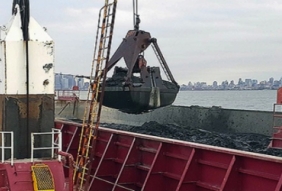
Posted on May 16, 2016
By Hugh Morley, JOC.com
The Port of New York and New Jersey will soon complete a multiyear $2.1 billion project to deepen its channel to 50 feet, enabling it to handle some of the biggest container ships afloat. But officials say the channel may need to be widened in certain locations to further ease the passage of the mega-ships that are expected to regularly call at the port in coming years.
The U.S. Army Corps of Engineers said it will in the next two weeks start the final phase of the dredging operation that it expects to finish in the next couple of months. But the Port Authority of New York and New Jersey wants to know whether the dredging is sufficient to handle all of the large ships that are expected to head for the port in the future, given the rapid growth in size of ships across the industry since the project was conceived, a senior Army Corp official told JOC.com.
Steve Coleman, spokesperson for the Port Authority, said the “general reevaluation study” that the agency has requested the Army Corps undertake will not impair the completion of the ongoing project. But it will ensure that the project, after substantial authority and federal investment, “continues to serve the needs of the Port, the region and the nation.”
The authority in March set aside funds for a study of what additional dredging may be needed in the port, and the Army Corps has submitted a cost-sharing plan, said Bryce Wisemiller, project manager for the agency’s harbor deepening project.
“Assuming that the agreement gets executed in the next few months, that study will get started,” he said, adding that the goal is to get it completed in three years.
New York-New Jersey is just one of several East Coast ports dredging their water in an effort to snare larger vessels. Savannah began a project to deepen its harbor to 47 feet last year that is expected to finish in 2018, and Charleston is looking at how to deepen its port to 52 feet. In Florida, The Port of Jacksonville plans to deepen the St. John’s River to 47 feet, with a completion date of 2020, and Virginia, although it has a 50-foot depth, is studying how to take it to 55 feet. Baltimore’s port already has a depth of 50 feet and Miami in September completed a project to take its port to that depth.
The late June opening of the Panama Canal expansion is expected to send ships with capacities of up to 14,000 twenty-foot-equivalent units to New York-New Jersey terminals. The biggest ships, for the moment, are only able to enter the Global Container Terminal in Bayonne, because it is in front of the Bayonne Bridge, which has a 151-foot vertical clearance. A project underway to raise the Bayonne Bridge by 64 feet, allowing mega-ships to reach the port’s other three terminals, is expected to be completed by the end of 2017.
“The port authority is looking at the feasibility of bringing in larger container ships than what the project was designed for,” Wisemiller said. “As a matter of fact, larger ships than what the project was designed for have already been utilizing the port, even though we haven’t fully completed the 50-foot deepening project yet.”
The port authority is partly concerned about whether the dredged channels are wide or deep enough for larger ships, which may not be able to turn or anchor in the harbor, Wisemiller said.
The dredging project, conceived in the mid-1980s to take the port depth to 45 feet was amended to take the depth to 50 feet in the late 1990s, when it was designed to handle ships of 6,000 TEUs, Wisemiller said. The initial completion date of 2012 was delayed by the discovery that rock in the channel was harder than expected, and a project to move water pipes linking Brooklyn and Staten Island out of the channel was set back by damage from Hurricane Sandy, Wisemiller said.
The Corps has dredged several channels, mostly to 50 feet but work still needs to be done to deepen the Ambrose Channel, at the mouth of the port, and the Anchorage Channel, just off the GCT.
The ports have already handled ships up to 50 percent larger than the 6,000 TEU ships that were originally planned for, among them the Clementine Maersk and the NYK Arcadia, both of which sailed under the Bayonne Bridge, Wisemiller said. The Clementine Maersk can take 8,650 containers, and the NYK Arcadia can carry 9,600 TEUs.
The first 10,000-TEU ship to stop at the Port of New York and New Jersey was the Zim Tianjin, which called at GCT in March 2015.
Source: JOC.com





